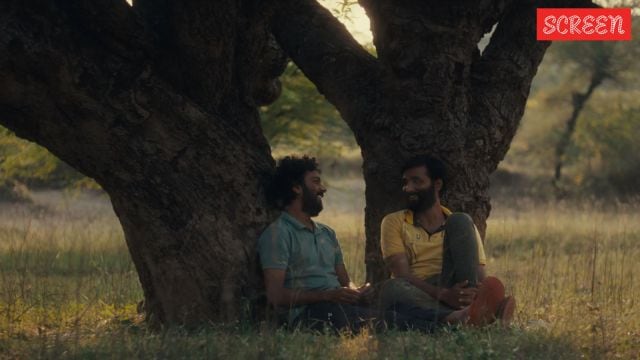Click here to follow Screen Digital on YouTube and stay updated with the latest from the world of cinema.
The visual poetics of Sabar Bonda, caught between stillness and scrutiny, distance and closeness
In Sabar Bonda, shot in a 1.66:1 aspect ratio, the camera remains completely static throughout.
 Sabar Bonda premiered at the 2025 Sundance Film Festival, becoming the first Marathi-language film ever to do so. It went on to win the World Cinema Grand Jury Prize: Dramatic.
Sabar Bonda premiered at the 2025 Sundance Film Festival, becoming the first Marathi-language film ever to do so. It went on to win the World Cinema Grand Jury Prize: Dramatic.In Sabar Bonda, the Marathi film that won at Sundance earlier this year and is now in theaters, the camera remains inert. Resolutely still, unmoved by the drama. It mostly favours wide, deep-focus compositions. This static gaze evokes a “fly on the wall” sensibility; as though director Rohan Parashuram Kanawade intends to attune himself to the lived rhythms of his characters. At one level, this formal stillness also gestures towards a heightened realism. A cinema that resists manipulation, allowing time to unfold unhurried, unadorned. The spectator becomes acutely aware of both space and duration. Nothing is coerced, everything simply is. And yet, Kanawade disrupts this aesthetic restraint. He punctuates the stillness with some sudden, extreme close-ups that refuse invisibility, calling attention to their own construction. These moments signal an articulation between stillness and scrutiny, distance and closeness. Alongside cinematographer Vikas Urs, Kanawade develops a visual language (shot in 1.66:1 aspect ratio) that does not decorate the narrative, but emerges organically from it. One could argue — persuasively — that without this precise, almost architectural attention to framing and temporality, the film’s emotional and thematic charge would diminish. After all, the intensity it carries is not incidental. It is fastidiously designed.
The film follows a relatively straightforward narrative: Anand (Bhushaan Manoj), having just lost his father, accompanies his mother Suman (Jayshri Jagtap) to their ancestral village to observe the traditional ten-day mourning period. Grief hangs heavily in the air, and visibly on Anand’s face, as the film opens with an extreme close-up of him seated in a hospital corridor. In the next shot, now in a wide frame, we see Suman seated on a bench nearby. The moment she sees a relative approaching, she breaks into loud sobs. Yet the camera remains static, distant, as Anand, Suman, and the surrounding relatives weep in a shared, wordless grief. This distance: formal, emotional, and spatial, becomes one of the film’s governing logics. For instance, when the family arrives at their village, the camera stays fixed inside the ambulance, watching Anand and his relatives step out and slowly vanish into the house. The shot is unbroken, the gaze withheld. It’s not just a stylistic choice. It’s arguably an articulation of Anand’s emotional remove: his estrangement from the extended family around him.
In these early scenes, the wide, static frames gesture toward a double entrapment. Anand, dislocated in a home that no longer feels like his own, and time itself, seemingly arrested in the rituals of mourning. But as the film unfolds, Anand rekindles his bond with his khaas dost, Balya (Suraaj Suman), a childhood friend and local farmer, and the same visual grammar begins to evolve and deepen. They find each other again on rooftops, gazing at stars, tracing constellations back to their childhoods. On bike rides to dairy farms, at each other’s homes listening to songs from Sairat, in the long, lazy afternoons of the village, where they speak of things lost: the disappearance of cactus pear plants, a beloved mango tree that once stood in the yard. In the fields, Anand follows Balya and his goats, and, here too, Urs composes wide, contemplative frames of the two of them sitting beneath a tree, almost as if caught in a faded photograph. Distance, once a measure of isolation, now becomes the vessel of their closeness. Time still pauses, but now in a romantic register. This is one of the film’s most graceful achievements: how the temporal connotations of stillness begin to shift in tandem with the emotional dynamics.
So when we finally see them getting intimate, the camera moves in extreme close-ups, where their faces appear at unexpected corners of the frame, geometrically askew. It’s as if the very composition is subversive, reflecting the rarity of queer love rendered with such peace, such exquisite gentleness. Perhaps that’s why they remain on the edges of the frame. In another film, their closeness would not be permitted. The form, even in its tenderness, carries the weight of threat. Perhaps, that’s why, sometimes these expansive frames begin to feel like warnings. They suggest the world is watching, encroaching. As the two draw closer, we fear for them. We wait for interruption. For violence. For the cut to reality. Because that is what cinema has conditioned us. But here the wide frames do not close in. Instead, they open further. The world, for once, makes room. Nature envelops them. The air breathes with them. And in this rare allowance, you’re reminded of Rumi’s words: Out beyond ideas of wrongdoing and right doing, there is a field. I’ll meet you there. When the soul lies down in that grass, the world is too full to talk about. Most films only imagine the light contained in that line. Sabar Bonda dares to show it.
- 01
- 02
- 03
- 04
- 05


































